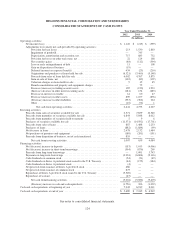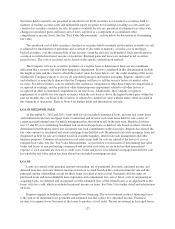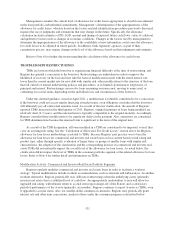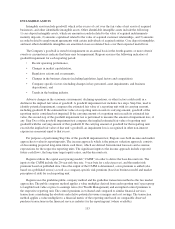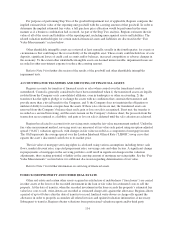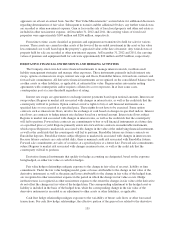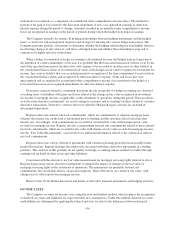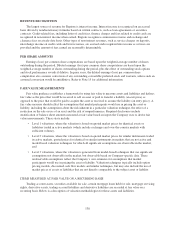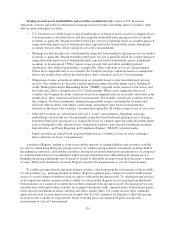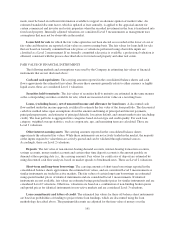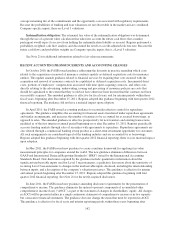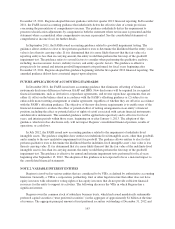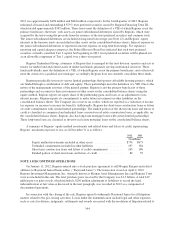Regions Bank 2012 Annual Report Download - page 150
Download and view the complete annual report
Please find page 150 of the 2012 Regions Bank annual report below. You can navigate through the pages in the report by either clicking on the pages listed below, or by using the keyword search tool below to find specific information within the annual report.For purposes of performing Step Two of the goodwill impairment test, if applicable, Regions compares the
implied estimated fair value of the reporting unit goodwill with the carrying amount of that goodwill. In order to
determine the implied estimated fair value, a full purchase price allocation would be performed in the same
manner as if a business combination had occurred. As part of the Step Two analysis, Regions estimates the fair
value of all of the assets and liabilities of the reporting unit, including unrecognized assets and liabilities. The
related valuation methodologies for certain material financial assets and liabilities are discussed in the “Fair
Value Measurements” section below.
Other identifiable intangible assets are reviewed at least annually, usually in the fourth quarter, for events or
circumstances that could impact the recoverability of the intangible asset. These events could include loss of core
deposits, significant losses of credit card accounts and/or balances, increased competition or adverse changes in
the economy. To the extent other identifiable intangible assets are deemed unrecoverable, impairment losses are
recorded in other non-interest expense to reduce the carrying amount.
Refer to Note 9 for further discussion of the results of the goodwill and other identifiable intangibles
impairment tests.
ACCOUNTING FOR TRANSFERS AND SERVICING OF FINANCIAL ASSETS
Regions accounts for transfers of financial assets as sales when control over the transferred assets is
surrendered. Control is generally considered to have been surrendered when 1) the transferred assets are legally
isolated from the Company or its consolidated affiliates, even in bankruptcy or other receivership, 2) the
transferee has the right to pledge or exchange the assets with no conditions that constrain the transferee and
provide more than a trivial benefit to the Company, and 3) the Company does not maintain the obligation or
unilateral ability to reclaim or repurchase the assets. If these sale criteria are met, the transferred assets are
removed from the Company’s balance sheet and a gain or loss on sale is recognized. If not met, the transfer is
recorded as a secured borrowing, and the assets remain on the Company’s balance sheet, the proceeds from the
transaction are recognized as a liability, and gain or loss on sale is deferred until the sale criterion are achieved.
Regions has elected to account for its servicing assets using the fair value measurement method. Under the
fair value measurement method, servicing assets are measured at fair value each period using an option-adjusted
spread (“OAS”) valuation approach, with changes in fair value recorded as a component of mortgage income.
The OAS represents the average spread over the London Interbank Offered Rate (“LIBOR”) swap curve that
equates the asset’s discounted cash flows to its market price.
The fair value of mortgage servicing rights is calculated using various assumptions including future cash
flows, market discount rates, expected prepayment rates, servicing costs and other factors. A significant change
in prepayments of mortgages in the servicing portfolio could result in significant changes in the valuation
adjustments, thus creating potential volatility in the carrying amount of mortgage servicing rights. See the “Fair
Value Measurements” section below for additional discussion regarding determination of fair value.
Refer to Note 7 for further information on servicing of financial assets.
FORECLOSED PROPERTY AND OTHER REAL ESTATE
Other real estate and certain other assets acquired in satisfaction of indebtedness (“foreclosure”) are carried
in other assets at the lower of the recorded investment in the loan or fair value less estimated costs to sell the
property. At the date of transfer, when the recorded investment in the loan exceeds the property’s estimated fair
value less costs to sell, write-downs are recorded as estimated charge-offs against the allowance. Regions allows
a period of up to 60 days after the date of transfer to record finalized write-downs as charge-offs against the
allowance in order to properly accumulate all related invoices and updated valuation information, if necessary.
Subsequent to transfer, Regions obtains valuations from professional valuation experts and/or third party
134


